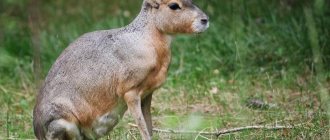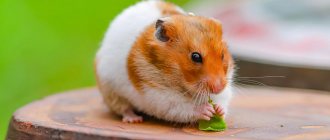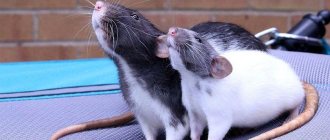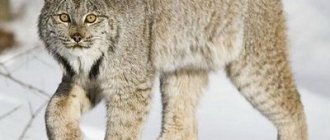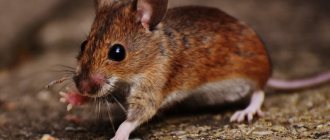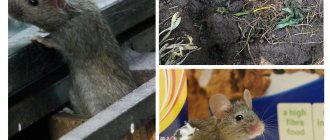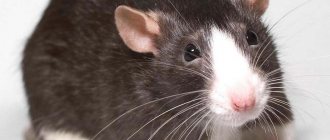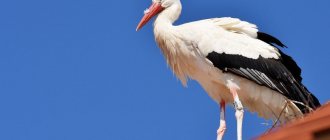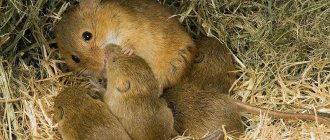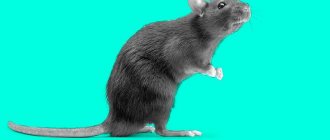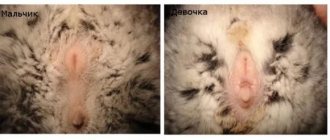Rodents are the richest order of mammals in terms of species diversity. Their characteristic feature is large incisors on the upper and lower jaws. The way of life, the functions performed by various parts of the body, and habitats determine the appearance of the various representatives of this order. The mass of rodents can range from five grams to several tens of kilograms.
Mammals of this order are found throughout the world. Where they did not exist, rodents were brought in specifically for various purposes. The only exceptions are the Antarctic region and some islands.
Family Gilts
Gilts live exclusively in South America in its most diverse climatic zones.
Representatives of this family have an elongated body, four-toed forelimbs and three-toed hind limbs, a short tail and neck, and a large head. Ears may be short, long, or absent altogether. The hairline is usually rough. The fur on the back is brown, gray, black or olive. The belly is light: color from white to dark yellow. Some species are nocturnal, others diurnal. However, none of them hibernate.
The family consists of 5 genera, which are represented by 15 species.
Abyssinian guinea pig
Peruvian guinea pig
Brazilian pig
Guinea pig
Djungarian hamster
This is a cute, active and inquisitive pet. The animals are distinguished by their fertility. Among the disadvantages, it is worth noting the short lifespan. They live up to 4 years.
They are nocturnal and do not require special care. They are fed morning and evening. You can use food for small rodents or prepare a mixture of oats, corn, peas, seeds, and nuts.
You can add carrots, zucchini, cucumber, greens, lettuce, apple, pear, and berries to your diet. Sometimes you can treat them to boiled chicken, low-fat cottage cheese, and unsalted lard.
It is forbidden to feed:
- potatoes;
- sausages and sausages;
- mushrooms;
- onions, garlic;
- cabbage;
- watermelon;
- citrus fruits;
- chocolate;
- cookies;
- honey;
- sugar;
- salt and spices.
The natural color is expressed in a gray-brown back, which has a pronounced black stripe and a light belly. In nurseries, varieties with pearl, tangerine, and sapphire colors are bred.
Hamsters love edible sticks and spikelets. To grind teeth, it is appropriate to use a mineral stone or a birch block. Animals are kept in cages or aquariums. Place it in a quiet place where there is no exposure to direct sunlight or drafts.
Djungarian hamsters.
Squirrel family
The family is divided into 5 subfamilies containing approximately 230 species. The most famous are the squirrel and the gopher.
Rodents of this family are widespread on all continents with the exception of Australia and Antarctica. A number of Arctic and tropical islands are also not inhabited by Squirrels.
These rodents can be small or large. Body length varies between 6-70 cm. Weight ranges from a few grams to 9 kg. All have a long tail covered with fur. Squirrels have strong, developed limbs and large eyes. The hair color can have stripes, spots or be one color: red, black, white, etc.
Chipmunk squirrel
prairie dog
Magellan tuco-tuco
Little chipmunk
Little gopher
Palm squirrel
Wood mouse
Body length ranges from 8 – 11.5 cm, tail length from 3 to 6 cm. Weight – 17 – 35 g. The color of the back is rusty-brown with a grayish-whitish belly. The tail is two-color.
Their habitat is forest and forest-steppe. They prefer to settle in deciduous and coniferous forests. Even swampy areas of forest-tundra are not alien to them. They are also able to climb mountains.
Activity is around the clock at any time of the year. The burrows are made shallow and short. They can hide in crevices of tree roots. They easily climb trees and bushes.
They feed on herbaceous plants, seeds, bark, shoots, moss, lichen, and invertebrates. In gardens and forests they cause harm and also transmit tick-borne typhus fever and leptospirosis. Mice are the main source of food for mustelids.
Forest mice.
Family Hedgehogs
The species composition of this family is not the largest. However, 24 different species are known.
All Ezhovs have a number of characteristics that unite them into one family. These include a pointed, elongated muzzle, well-developed eyes and ears, and limbs with five fingers. A distinctive feature of the family is the skin with many needles interspersed with hairs of wool. These rodents also have a special muscle that runs through their entire body. She helps the animal curl up into a ball, escaping from predators.
The habitat of hedgehogs is Central and South Asia, Europe. They were once introduced to islands near Africa, where they spread safely.
Hedgehog
Mouse-like hamster
Mouse-like hamster.
The mouse-like rodent can live in rock crevices in the wild. When jumping, it reaches 30 cm from the ground when it senses danger. Small groups gather in one nest, where they hide from the cold and predators.
The diet consists of seeds, flowers, leaves, animal feed, insects, and carrion. In captivity, they are able to reproduce at any time of the year, in nature from March to December. Life expectancy is more than 9 years at home, in the natural environment about 2 years.
Family Mole rats
Mole rats are burrowing animals that are adapted to life underground. The family is divided into three subfamilies, which include more than 30 species of rodents.
Characteristic features of animals of this family are half-blind eyes, underdeveloped ears, short thick fur, and short limbs. The length of the body of various species can be from 0.13 to 0.48 m, and weigh from 100 g to 4 kg. Some species have powerful incisors with which they dig the ground. Other rodents use their front paws for this.
Mole rats live in Europe, Asia, and northeast Africa. They are also found on Russian territory.
Small bamboo rat
Lesser mole rat
Jerboas
Of all the rodents, only one moves on two limbs - the jerboa. The animal lives in hot areas of the Palaearctic biogeographic region. It inhabits deserts, semi-deserts, and can live in steppes, some forest-steppes and mountains. The jerboa is found in southern Siberia, Kazakhstan, North Africa, China, Western Asia, and Mongolia.
Harsh living conditions affected the lifestyle, and most importantly, the appearance of the rodent. The animal has developed hind legs, the length of which is four times longer than the front legs and twice as long as the body. The jerboa moves in leaps up to three meters long and can reach speeds of up to 50 km/h. When moving slowly, it moves to four paws.
The body of the rodent reaches from 4 to 25 centimeters. It is covered with thick brown or yellowish fur, similar in color to sand. The animals have a large head, short neck, large eyes and long ears. The long-eared jerboa boasts the largest “locators”. The tail is usually longer than the body, and is equipped with a fluffy tassel at the end. It is necessary for balance and turning while jumping.
Jerboas are nocturnal, escaping the heat in their burrows. They build different types of burrows. Some serve as temporary shelter from the sun, others serve as shelter from sudden attacks by predators, and in others they live. Permanent housing is necessarily equipped with emergency passages through which the rodent escapes if its hole is discovered.
Family Jerboa
These rodents live in desert, semi-desert, steppe, and low mountain areas. They inhabited northern Africa, some parts of Europe, Asia, Kazakhstan, southern Siberia, etc.
These mammals have a short body, elongated hind legs, and short forelimbs, with which they remove the earth dug out with their incisors. The size of these rodents is 4-25 cm, weight no more than 300 g. All species have a very long tail, which serves as a rudder and balancer when running. These animals have a short neck, a large head, long rounded ears and a uniform skin of beige-brown shades.
Jerboas, with rare exceptions, are nocturnal. They dig burrows, feed on plants and insects, and bear offspring one to three times a year.
Small jerboa
Desert jerboa
Classification
Rodents are classified in the following taxonomic hierarchy:
- Domain: Eukaryotes;
- Kingdom: Animals;
- Phylum: Chordata;
- Class: Mammals;
- Order: Rodents.
Scientists agree on the definitions of most families, but they have historically disagreed about organizing families into larger groups, namely suborders. In early classifications, suborders were generally omitted, and families were grouped into superfamilies. The latest official classification identifies five suborders, whose representatives have similar features:
- Porcupines (Hystricomorpha): There are approximately 300 species of porcupine rodents living today. Members of this suborder include agoutis, porcupines, mole rats, nutrias, chinchillas, capybaras and many others. Hystricomorpha rodents have a unique arrangement of jaw muscles that sets them apart from other rodents.
- Myomorpha: There are about 1,400 species of living mouse-like rodents. This group includes mice, rats, hamsters, voles, lemmings, jerboas, muskrats, etc. Most species of mouse-like rodents are nocturnal; they feed on seeds and grains.
- Anomaluromorpha: has nine species, including the spiny-tailed squirrels, Pela's spiny-tails, long-eared spinytails, Cape striders, etc. Some members of this suborder (except the spiny-tailed squirrels) have flight membranes that allow them to glide.
- Squirrel-like rodents (Sciuromorpha): There are about 273 species of squirrel-like rodents. Members of this suborder include squirrels, chipmunks, marmots, flying squirrels, etc. Squirrels have a unique arrangement of jaw muscles that distinguishes them from all other rodents.
- Beavers (Castorimorpha) : has about 100 species from 3 families: beavers, gophers and pouchhoppers. This suborder was identified in 2005.
Family Gerbils
Gerbils are small rodents that look like mice. They can reach 20 cm in length depending on the species. Their weight ranges from 10 to 225 grams. These animals have a long tail, rather large eyes, and protruding ears. The color of their fur is unremarkable: the back is sandy or brown, and the belly is light.
The habitats of these rodents are desert, semi-desert, and steppe areas. They are widespread in Central Asia, Kazakhstan, and also in Africa. They are found in the smallest quantities in the Caspian region and Transbaikalia.
Gerbil Sundevalla
Sand mole rat
Agricultural pests
Rodents that feed on grain crops are serious pests, destroying both growing crops and already harvested crops. In Asia, rodents are one of the main factors limiting rice production. Separately, it should be noted the damage caused by rodents to books and other paper products.
The structure and appearance of rodents
The majority of rodents are relatively small in size. But among them there are small and large animals: from a dwarf mouse weighing 7 g and 3 cm long to a ninety-kilogram capybara, reaching up to 130 cm in length. Rodents usually have such a long tail that it can be twice or even three times as long as their body. But in many representatives of the Miguels this organ may be completely absent. Animals of this order can have different body shapes. It depends on what kind of life is inherent in a particular clan. For example, for those who have to move a lot from place to place, sometimes even jumping, the hind limbs in the process of evolution have become much longer than the front ones. This applies to Tushkanchikovs and Belichichs. Those who need to dig holes for shelter and search for food need strong front paws with powerful claws and a rounded body shape.
The anterior incisors in rodents are enlarged and separated from the chewing teeth by a diastema. They have the ability to self-sharpen. Rodents also have no fangs at all. The skeleton of mammals is represented by a spine with 30 main vertebrae and an individual number of tail vertebrae, four limbs, a massive skull, and large eye sockets. The number and size of bones depend on the specific representative.
The body of rodents is covered with hair, usually of equal length and not very striking colors. In some of them, the hairs have formed into needles (the Hedgehog family). On the front part of the animals there are vibrissae, which perform the function of touch.
Pacarana
Another name for it is false pack . The pacarana looks like a guinea pig, but is a fairly large rodent. Her body length is from 73 to 79 cm, she weighs 10-15 kg.
This is a massive, heavy animal. The tail is about a third of the body in size. She has a wide head, on which there are round ears and unusually large eyes.
Pacarana is black or dark brown, has white spots, and has coarse and sparse fur. You can meet her in the forests of the Amazon. These are slow animals. Not much is known about their life.
Characteristics and features
Rodents appeared on the planet more than 60 million years ago and have evolved greatly since then. Some species developed and changed, others completely disappeared.
Representatives of the rodent order inhabit a wide variety of climatic zones, living in warm and cold, wet and dry places, near water bodies and deep in forests, on plains and in mountainous areas. They live on the ground, underground, in trees, in swamps. And some species have even mastered the airspace, for example, the flying squirrel.
Various rodents exhibit vital activity either at night and twilight, or during the daytime.
These mammals can exist in groups with different numbers of individuals or be solitary. Their brain is quite large in size and does not have convolutions on its surface. Rodents are quite smart animals, they can perform the simplest actions, they have their own language for communication.
Well-developed sensory organs responsible for tactile sensations, hearing and smell enable rodents to recognize danger in time and avoid it, communicate with their own kind, find food and everything necessary for existence.
Rodents have elongated intestines. This is due to the consumption of food mainly of plant origin.
Steppe pied
Until recently, this species was considered a dangerous pest. However, due to the small number of remaining individuals, they were included in the Red Book . Habitat: steppes, semi-deserts, forest-steppes. It can live in river valleys and lake basins, as well as on the slopes of ravines.
Activity is around the clock. Burrows at a depth of 30–90 cm. In winter, they can build a tunnel under the snow. The body is 8–12 cm long, the tail length is 7–9 mm. Life expectancy reaches 20 months, although in captivity some live up to 2 years.
The color is monochromatic. They feed on tubers, bulbs, seeds, bark of shrubs, and green parts of narrow-leaved cereals.
They themselves are prey for the fox and corsac. A fox can eat 100 animals within a month.
Steppe moth.
Rodent nutrition
The basis of nutrition of these mammals is plant food. They eat leaves, shoots, seeds, berries, gnaw twigs, bark, etc. But not all rodents are only herbivores. There are also omnivores among them, who, along with roots and herbs, eat insects, snails, worms, bird eggs, and small vertebrates (for example, lizards). Species living near water can feed on fish, shellfish and various crustaceans.
Animals spend a significant part of their lives getting food. Some representatives, mainly among Khomyakov, Squirrel and Mouse, store food for the winter in burrows and hollows.
The diet of rodents depends on the seasonality of the year. In summer, food is varied and includes seeds, plant parts, insects, etc. In autumn, berries, fruits and root vegetables. In winter, wood, bark and roots. In spring, the first young shoots and leaves begin to grow, which are necessary for the growth and development of the body.
The weather also affects the diet. In hot weather, rodents forage for food at night, when it is cooler. When daytime temperatures drop, they become active during daylight hours. Weather, age, and place in the hierarchy (for social species) also influence feeding behavior.
You can read what squirrels eat in the forest in winter and summer in a special article -
Gray hamster
A small and short-tailed animal. Body length is 9.5 - 13 cm, tail length is from 2 to 3.5 cm. The color can be smoky gray, dark gray or brownish gray. Reddish-sandy individuals are rare. They store supplies in their burrows. The hole can only be in a dry place . The supply of seeds for the winter period reaches 1 kg. Activity is observed at night.
In nature, their diet consists of seeds and inflorescences of wild cereals. They do not refuse green shoots of plants. Larvae and land mollusks are a favorite delicacy. In this regard, insect larvae are included in the pet’s diet. Give food little by little, avoiding overeating. The water must be fresh.
This variety is used by scientific institutions in laboratory research.
Gray hamster.
Reproduction of rodents
Animals of this order are very prolific. Females of small species can have several litters per year: from two to five. Moreover, each litter usually contains several cubs at once. The quantity varies from 5 to 15 pieces. And larger representatives of the order give birth once a year and no more than three cubs.
Some species give birth to underdeveloped young that require long-term care. And there are some animals that, after birth, are almost immediately ready to move independently.
Not only the number of annual litters varies greatly among species, but also the duration of pregnancy. In small animals it is short - only 18-20 days. And the larger the animal, the longer the pregnancy lasts. Muskrats, for example, remain in position for about 30 days, and nutria and capybaras for more than four months.
The population size depends on many environmental factors. In conditions of lack of food, it decreases, and vice versa. When the population increases excessively, some animals are even forced to migrate from their homes in search of new habitats.
Squirrels
Squirrels are common inhabitants of city parks. They inhabit Europe, temperate Asia, and America. They have a long body and a large bushy tail. The muzzle is vaguely similar to that of a mouse, but more rounded and blunt. The animal's ears are long and pointed, sometimes with fur tassels.
Their strong, muscular legs help them climb trees and jump long distances. An impressive tail is needed for balance. The color of animals ranges from bright red (common squirrel, red-tailed squirrel) and brown (Bolivian) to black and gray (Arizona, Yucatan). In winter, the fur becomes lush and thick, in summer it thins out and becomes short.
Giant squirrels are the largest representatives of the genus. They are almost twice the size of the common squirrel, reaching a length of up to 50 centimeters. The smallest are mouse squirrels. Their size does not exceed 8 centimeters.
Animals inhabit forests because they spend most of their lives in trees. They descend only to search for food and water, and also to hide what they find under a layer of foliage. They feed on both plant and animal foods. They can eat nuts, seeds, mushrooms, as well as frogs, chicks and beetles. In winter, they find food even under a thick layer of snow, tearing apart their own and other people's hiding places.
The importance of rodents in human life
The importance of rodents in human life is enormous. Some of them are a source of valuable furs, for example, the muskrat. Others are hunted for their meat and fat. Experiments are carried out on laboratory rodents to study diseases, drugs and other chemicals.
Rodents carry plant seeds, and underground inhabitants also loosen the soil, enriching it with oxygen and allowing water to better penetrate into the ground. They are hunted by predatory mammals. All this ultimately benefits the person.
Rodents also cause significant harm. They are carriers of various bacterial and viral infections, parasites and fungi. Rodents also cause harm to agriculture and households by eating, contaminating food and spoiling things. Therefore, in order to protect himself and his property, people regulate the number of synanthropes using traps and pesticides.
Representatives of the rodent order adapt well to changes in external living conditions. This makes it possible to tame them. Some species have long become familiar domestic animals. People keep some types of rats, guinea pigs, hamsters and others.
Rodents are an intermediate component of food chains that transform the biological mass of plants and animals. Their irrational destruction harms natural ecosystems. Therefore, they, as part of nature, suffering from the consequences of human activity, need to be preserved and protected.
Disease carriers
Rodents living in close proximity to humans, whether pets or wild animals, are carriers of diseases. For example, rodents are traditional sources of listeria infection. In addition, proteins in the urine or blood serum of rodents can cause allergies. Chipmunks are natural carriers of at least 8 pathogens of dangerous diseases, such as tick-borne encephalitis, rickettsiosis, toxoplasmosis, etc. Marmots are natural carriers of bubonic plague.
Porcupines
Porcupines are the third largest rodent, reaching from 40 to 90 cm. Evolution has turned part of its fur into spines. Thanks to this, the fat and overweight porcupine became practically inaccessible to predators. Its needles seriously injure animals and can make them disabled, incapable of fast and dexterous hunting. Because of this, predators often switch to catching slower prey - humans, which becomes a serious threat to us.
Reliable protection made the rodent fearless. When danger appears, he does not retreat. Shaking its needles, it first warns the enemy, and then attacks him, approaching him with his back. Courage plays a trick on him when the animal tries to attack fast-moving cars.
The porcupine lives in foothills and deserts. It is common in India, the Middle East, Asia Minor, Italy, Transcaucasia and the Arabian Peninsula. It arranges housing in small caves and rock openings or in burrows if the soil allows them to be dug. A rodent's home can be up to 4 meters deep and up to 10 m long. The animal often lives next to humans, feeding on crops from fields and vegetable gardens.
The rodent is nocturnal. It does not hibernate, but in cold weather its activity is greatly reduced. It feeds on tree bark, plant tubers, watermelons, pumpkins, grapes and even cucumbers. Occasionally may eat insects. In the past, animals themselves became food. People caught them for their juicy and tender meat, which is said to be tastier than rabbit.
